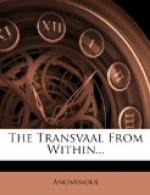The Boers then invaded Natal and took up a position on Laing’s Nek, four miles inside the Natal border, from which, on January 28, Sir George Colley endeavoured to oust them with a mounted force of 70 men and some 500 men of the 58th Regiment. The position is one difficult enough to climb unencumbered by military accoutrements, but the disposition of the little mounted force covered the approach. By some unexplained mistake, however, half of the mounted infantry charged and carried the Boer position before the 58th had climbed the hill, but were too weak to hold it and retired, leaving the 58th uncovered in a terrible ascent. But few of the exhausted men reached the top of the hill, and those, led by Colonel Deane, only to be shot down. Of the mounted men, 17 were killed and wounded; of the 58th, 73 were killed and 100 wounded. The result was absolute defeat of the British forces. The number of Boers engaged is not known, but the force behind the Nek consisted of several thousands, and no doubt a fair proportion engaged in the fight.
On February 8 General Colley made a demonstration in force on the Ingogo Heights. The force consisted of under 300 men, with 4 guns and 38 mounted men. On the Boer side there were about 1,000 men, and the fight lasted from morning until after dark. It was a drawn fight, in which both parties left the battlefield at night. There cannot be any doubt, however, that the balance of advantage was with the Boers, since the loss on the British side was very severe: 76 men were killed and 69 wounded.
On February 27 came Majuba, when Sir George Colley designed to retrieve his fortunes and strike an effective blow without the aid of his second-in-command, Sir Evelyn Wood, whom he had sent to hurry up reinforcements. The scaling of the mountain at night was a fine performance. The neglect to take the rocket apparatus or mountain guns, or to fortify the position in any way, or even to acquaint the members of the force with the nature of the position which they had taken up in the dark, and the failure to use the bayonets, were the principal causes of disaster. The Boers attacked in force a position which should have been absolutely impregnable, held as it was by a force of 554 soldiers. The Boer force is not known, but probably consisted of upwards of 1,000 men, since Christian Joubert after the fight offered to take a portion of the men, numbering, as he said, some 500, to attack a small British laager on one of the spurs of the mountain. The splendid feat of taking the hill-top, however, was accomplished by a small storming party of less than 200 men, the balance of the Boer forces covering the approach of their comrades by an accurate and incessant long-range fire. The result, as is known, was terrible disaster: 92 killed and 134 wounded, and a number taken prisoners, represented the British loss, whilst the Boers lost 1 killed and 5 wounded. No attempt had been made to occupy positions below the crown of the hill which




